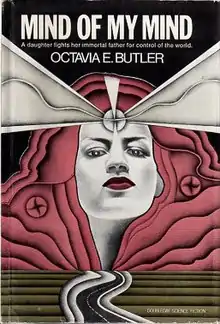Mind of My Mind
Mind of My Mind (1977) is a science fiction novel by American writer Octavia E. Butler. Mind of My Mind is the sequel to Butler's novel Patternmaster, and is the second novel in the Patternist series.
 First edition (US) | |
| Author | Octavia Butler |
|---|---|
| Cover artist | Jan Esteves |
| Language | English |
| Series | Patternist |
| Genre | Science fiction |
| Publisher | Doubleday (US) Sidgwick & Jackson (UK) |
Publication date | 1977 |
| Pages | 169 |
| ISBN | 978-0-385-12600-7 |
| OCLC | 2984449 |
| Preceded by | Patternmaster |
| Followed by | Clay's Ark |
Plot
This second novel in the series recounts the story of how the Patternist society originated. The novel is set in Forsyth, California, a city near Los Angeles, in the 1970s. The leader of the telepathic humans that later became known as the Patternists, was a man originally from Africa named Doro. Doro is about 4,000 years old and immortal. Since Doro does not have physical immortality, he must move his essence to different bodies as time goes on for his continued survival. Doro tends to procreate with and breed people who are telepathically sensitive, in an effort to make a group of superhuman telepaths. The story is focused on one of Doro's daughters, named Mary, who is a young, poor biracial woman. Doro's hope is that his daughter Mary will connect with other telepaths and ultimately become an exceptional telepath who is able to link with other telepathic people.
In the midst of Mary's status change from a "latent" to an "active" telepath, she makes the first ever Pattern as a result of her attaching mentally onto six other active telepathic people. Two years later, after Mary has added 1,500 people to her community of Patternists, Doro thinks Mary has acquired too much power and demands that she stop acquiring telepaths. This creates a conflict, as Mary will destroy herself and as a result all Patternists if she discontinues the expansion of her Patternist community. With support from her people, Mary gains the strength to fight and ultimately kill Doro. There are many Patternist casualties in the fight; however, Mary is ultimately able to continue to grow and protect the Patternist society she has created.
Characters
- Mary: A young biracial woman from a poor neighborhood with a latent paranormal ability. Strong willed and independent. Daughter of Doro. Mary must overcome her Patternist father/lover. In this novel Mary shows that being a loner can make you a more independent person. During Mary's transition from "latent" to "active" telepath, Mary creates the first Pattern by mentally latching onto six active telepaths. Mary eventually adds fifteen hundred people to her Patternist community. Mary's father Doro thinks that she has too much power and orders her to cease her additions of Patternists; Mary then kills her father.
- Doro: A four-thousand-year-old immortal originally from a region near the Nile River in Africa that he says was later called Nubia. Doro is the father (both literally and figuratively) of the telepathic group of humans who become the Patternists. Doro is eventually killed by his daughter Mary.
- Emma: A distant relative of Mary, previously known in Wild Seed as Anyanwu. She is immortal, a healer, and a shape-shifter. Emma agrees to let Mary and her mother, Rina, move into an apartment she owned to ensure that Mary makes it to adulthood at the request of Doro.
- Rina: Mary's mother. She is a sex-worker and an alcoholic. Doro uses Rina for his "breeding program" in hopes of creating a telepath better than all the previous ones he has sired. Having Mary has adverse effects on her mind.
- Karl: Mary's husband and an active telepath, Doro's strongest telepath until Mary goes through her transition.
References
Further reading
- Bogstad, Janice. "Octavia E. Butler and Power Relations." Janus 4.4 (1978–79): 28-29.
- Gant-Britton, Lisbeth. "Butler, Octavia (1947– )." African American Writers. Ed. Valerie Smith. 2nd ed. Vol. 1. New York: Charles Scribner's Sons, 2001. 95-110.
- Green, Michelle Erica. "'There Goes the Neighborhood': Octavia Butler's Demand for Diversity in Utopias." Utopian and Science Fiction by Women: Worlds of Difference. Ed. Jane L. Donawerth and Carol A. Kolmerten. Syracuse University Press, 1994. 166-189. Rpt. in Contemporary Literary Criticism. Ed. Jeffrey W. Hunter and Polly Vedder. Vol. 121. Gale, 2000. Artemis Literary Sources. Web. 1 February 2016.
- Holden, Rebecca J. "'I Began Writing about Power Because I Had So Little': The Impact of Octavia Butler's Early Work on Feminist Science Fiction as a Whole (and on One Feminist Science Fiction Scholar in Particular)." Strange Matings: Science Fiction, Feminism, African American Voices, and Octavia E. Butler. Ed. Rebecca J. Holden and Nisi Shawl. Seattle, WA: Aqueduct, 2013. 1744. MLA International Bibliography. Web. 1 February 2016.
- Ferreira, Maria Aline. "Symbiotic Bodies and Evolutionary Tropes in the Work of Octavia Butler." Science Fiction Studies 37.3 [112] (2010): 401-415.
- Pfeiffer, John R. "Butler, Octavia Estelle (b. 1947)." Science Fiction Writers: Critical Studies of the Major Authors from the Early Nineteenth Century to the Present Day. Ed. Richard Bleiler. 2nd ed. New York: Charles Scribner's Sons, 1999. 147-158.
- Salvaggio, Ruth. "Octavia Butler and the Black ScienceFiction Heroine." Black American Literature Forum 18.2 (1984): 78-81.
- Smith, Frances Foster. "Octavia Butler's Black Female Fiction." Extrapolation, Vol. 23, No. 1, Spring, 1982, pp. 37–49.
External links
- Mind of My Mind (Doubleday 1977; Warner 1994; in Seed to Harvest, Grand Central Publishing 2007).